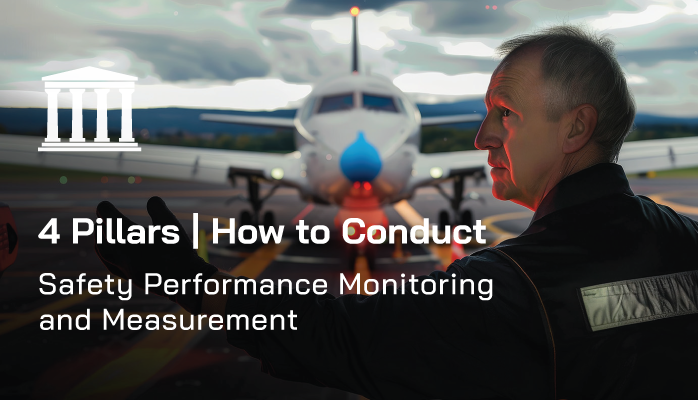What Is Safety Performance Monitoring and Measurement

Safety performance monitoring is an essential component of aviation safety management systems (SMS). And by “essential,” performance monitoring is like your SMS implementation's immune system.
When performance monitoring is not handled well, your safety program will wither. Worse yet, your operating certificate may be in jeopardy.
Do you know what performance monitoring looks like?
SMS performance monitoring basically involves the ongoing (real-time) collection of safety data metrics that indicate the health and progress of an aviation SMS implementation. It is also used to ensure that key safety goals are achieved.
Safety performance monitoring and measurement is an element of the Safety Assurance Component of the Four Pillars of SMS.
Related Articles on Aviation Safety Performance Monitoring
- How to Monitor Aviation SMS Performance - Safety Chart
- KPI Dashboard Monitoring Guidelines for Aviation SMS - With Free KPI Resources
- 5 Useful Safety Performance Monitoring Tools in Aviation SMS
Accountable Executive's Concern for Monitoring Safety Performance
For every aviation SMS implementation, the accountable executive is responsible for ensuring the SMS implementation is performing as designed across the entire organization. In order to fulfill this responsibility, the responsible manager(s) and process owners will need processes to monitor the SMS implementation's effectiveness as well as monitor risk management activities.
Accountable executives are expected to provide active oversight of the SMS implementation. Active oversight is expected from accountable executives because they are also responsible for directly managing substandard safety performance as it is detected. In order to provide this oversight, modern, SMS data management tools allow safety teams to regularly review organizational safety performance.
Several low-cost, commercially available SMS databases allow upper management real-time access to monitoring their SMS risk management activities. Whenever accountable executives require increased levels of oversight, it is recommended that they acquire an SMS database that allows a collaborative team approach to managing the aviation SMS versus having a spreadsheet SMS to which only the safety team has access.
Besides providing accountable executives unfettered access to SMS data, SMS databases have robust performance monitoring dashboards that can be configured for each individual user. These SMS dashboards may come preconfigured. SMS dashboard charts offer assurance to account executives and give them the peace of mind that there won't be any surprises when the SMS auditors pay a site visit.
Proactive and Reactive Performance Monitoring

When we discuss monitoring safety performance, there are two types:
- Proactive performance monitoring; and
- Reactive performance monitoring.
Proactive performance monitoring involves monitoring data that indicates performance before a hazard expresses itself. It is sometimes known as a Top Event or Risk Event. For example:
- % of acceptable reported issues per month;
- Number of proactive issues reported per month;
- % employees who have completed hazard identification training;
- Average time to implement preventative actions (i.e., CPAs that are preventative);
- Average time (frequency) between risk control reviews, hazard reviews; policy/procedure updates, etc.;
- Frequency between safety meetings;
- Average likelihood of risk assessments over time;
- And so on.
Proactive monitoring activities check progress of suppressing risk likelihood.
Related Articles on Proactive Risk Management in Aviation SMS
- What Is Proactive Risk Management in Aviation SMS?
- 3 Things Preventing Effective Proactive Risk Management in Aviation SMS
- How to Practice Proactive Risk Management in Aviation Safety
Proactive and Reactive Performance Monitoring Equally Important
Despite the fact that reactive risk management has the poor reputation of being proactive risk management’s less desirable younger brother, reactive performance monitoring is equally important. Reactive risk management monitoring assesses how well the SMS (employees and risk controls) are able to mitigate risky situations once a risk expresses itself.
Some types of reactive performance monitoring data are:
- Average time to close low, medium, and high-risk issues (over time);
- Average time to implement corrective actions (i.e. CPAs that are corrective);
- Number of safety incidents in which damages were successfully mitigated;
- Average severity of risk assessments over time;
- Number of unacceptable issues reported per month;
- And so on.
Both proactive and reactive risk management performance needs to be monitored.
Safety Data for Monitoring Safety Performance in SMS
Beyond the above-listed proactive and reactive risk management performance monitoring metrics, the most important safety data to your program will be (you guessed it) your key performance indicators:
- Key: most important safety data metrics;
- Performance: quantifies actions and activities in SMS; and
- Indicator: show whether or not objectives are being met.
Performance monitoring should be prepared with four types of safety data:
- Primary: key performance indicators;
- Secondary: other performance metrics, such as leading and lagging indicators;
- Human Resources: metrics used for employee performance monitoring (next section); and
- Bureaucratic: metrics used to quantify bureaucratic efficiency.
Monitoring key performance indicators helps asses how well safety goals and objectives are being met, and secondary metrics will ensure that you are keeping tabs on all other important safety aspects of the aviation SMS implementation.
Related Aviation KPI Articles
- What Is a Key Performance Indicator (KPI) in Aviation SMS?
- How to Set and Monitor Key Performance Indicators (KPIs) in Existing SMS
- How to Automate Key Performance Indicator KPI Monitoring in Aviation SMS
Employee Performance Monitoring
Employee performance monitoring is an indispensable resource for building quality safety behavior and safety culture. The fact is that employees will behave differently when they feel that someone "who matters" is watching.
It’s nice to dream about working towards a safety culture where employees are dedicated to safety even when the boss isn’t watching. However, the reality is that, while there may be a few employees who do this, the vast majority will only follow safety policy if they have a personal incentive to do so. In this case, the best incentive is:
- That safety performance shows up on their performance reviews.
Employee safety performance monitoring should be naturally included in all performance reviews and a condition for career advancement. There should be no “separate” safety reviews. Safety needs to be considered on par with any other quality performance requirement of the employee’s position.
Fortunately, setting up employee performance monitoring is fairly straightforward. To learn how to do this, see the workflow.
How to Monitor Safety Culture

Aviation safety culture leads directly to safety performance. You could even make an argument that SMS bureaucracy aside, safety culture is safety performance.
But trying to get a handle on influencing or monitoring safety culture is notoriously difficult. After all, what is safety culture? There are many definitions out there. However, it makes less sense to try and define safety culture than it does to simply show:
- What are the different types of safety culture?
- What are characteristics of effective safety culture?
- What are signs of mature safety culture?
Leading indicators are crucial for safety culture performance monitoring. Safety culture is often the underlying cause of many safety incidents. Leading indicators are designed to assess and monitor underlying causes – known as “inputs” into safety performance.
To facilitate monitoring your safety culture, it makes sense to find leading indicators that measure the kind of safety culture you feel benefits your organization the most.
This list of leading indicators ought to help out tremendously.
Related Aviation Safety Culture Articles
- What Is Safety Culture in the Aviation Industry?
- How to Monitor Aviation SMS' Safety Culture Performance
- How to Monitor Aviation Safety Reporting Culture Using Safety Charts
Fulfilling Compliance With Safety Performance Monitoring
Compliance is met when:
- Aviation safety goals and objectives are established;
- KPIs have been defined, implemented, and analyzed for trends;
- Risk controls are monitored/verified/audited to confirm they are working effectively;
- Safety objectives and performance indicators are reviewed and updated periodically;
- Safety objectives are SMART; and
- Information obtained from safety assurance and compliance monitoring activities informs the safety risk management process.
Final Thoughts on Monitoring Safety Performance in Aviation SMS
Take a moment and review the list of items above that demonstrate compliance for safety performance monitoring. As you can imagine, if your company has more than 100 employees, your SMS data management strategy requires careful consideration.
- Can you easily set KPIs?
- Can you easily monitor KPIs?
- Can you easily classify and risk assess reported safety issues?
- Can you easily generate SMS performance monitoring charts for the accountable executive?
The final point is very important, as the accountable executive will need to regularly review organizational safety performance. Furthermore, as your company becomes larger and more complex, the SMS performance monitoring activities extend to operational department heads.
In a perfect world, operational department heads and accountable executives will be able to monitor SMS performance without having to beg the safety team for reports. Modern SMS databases are user-friendly. Dashboard charts are visual and show managers key performance information required for decision-making processes.
An SMS database provides management with assurance that reported safety issues are managed in a repeatable, industry-accepted manner.
- Do you use an SMS database?
- Does it provide you the value you expect? Is it user-friendly?
Learn how you can benefit from a low-cost, commercial SMS database. Below are some short demo videos.
Last updated December 2024.








